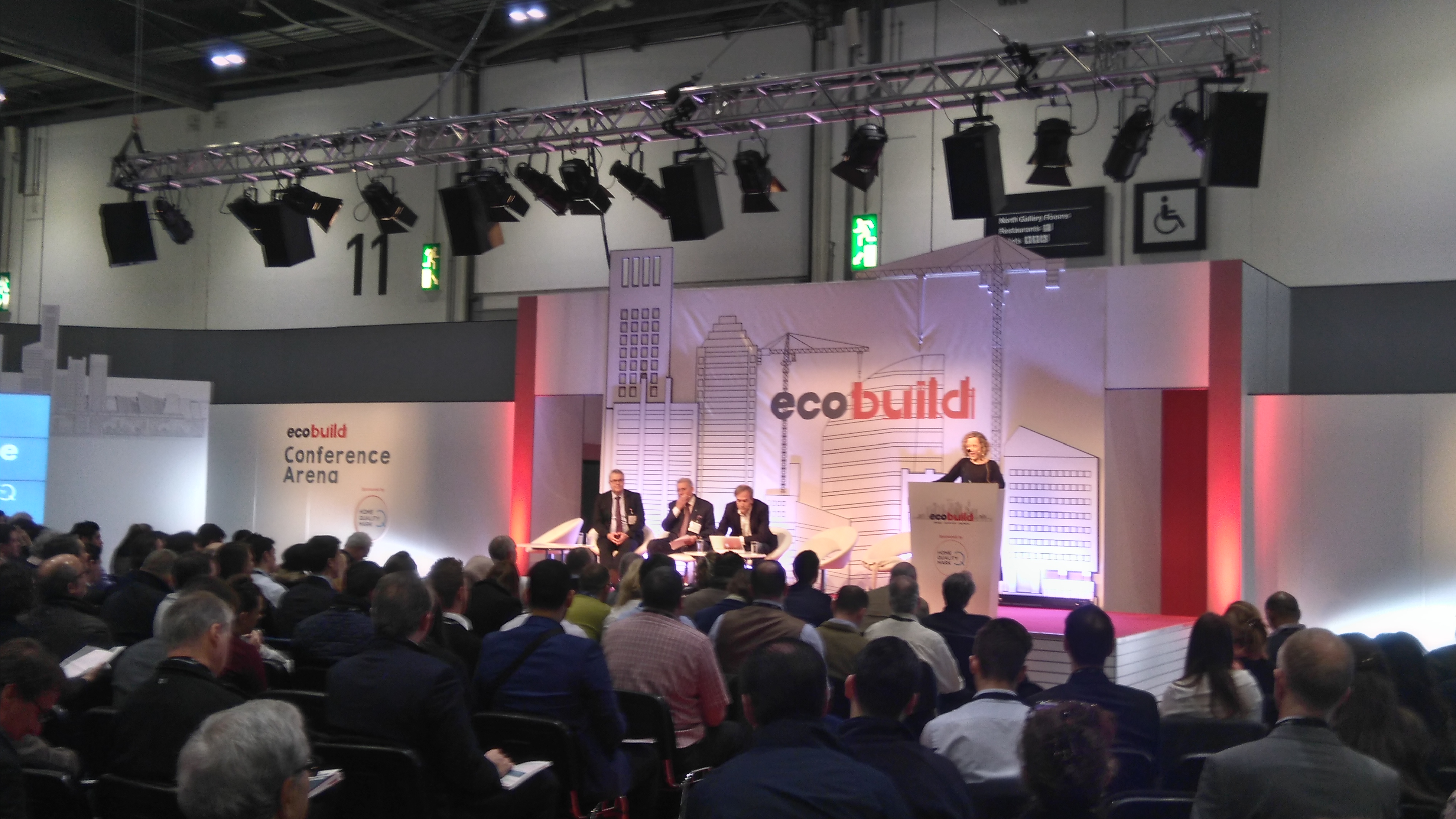Ecobuild 2016 - What makes good housing?
Designing Buildings Wiki went to the Excel Centre for day one of EcoBuild 2016, the UK's largest construction and energy event.
One of the main topics of discussion was housing, with the day's conference chair Cathy Newman (from Channel 4 News) opening by saying that in a time when people are living in garden sheds and the median house price is 12x the average income, the term 'housing crisis' is well justified.
On the question of 'What makes good housing?', Tony Pidgley, the Chairman of Berkeley Group, held to the mantra of 'affordability and additionality'. He said Berkeley's central focus was on the needs of inhabitants, that as stakeholders they are engaged right from the point at which each contract is won.
He dismissed the new London Design Guides, asking “do you really need minimum sizes? Do you really need a balcony that will cost £10,000?”
Rowan Moore, architecture critic for The Observer disagreed, saying that the sheer stress of numbers in a city such as London meant the quality of life for its inhabitants was constantly being squeezed.
Since people will buy anything that gives them a foothold, Moore said, planners will approve anything so they achieve the required numbers. His view was that politicians should be questioning the policies made 30-60 years ago; such as re-examining public housing, and building more on the green belt, which he argued was of precious little interest or utility to the average Londoner. If, he said, government and planners can annoy a lot of people with HS2 why can't that same sense of purpose and will go into housing policy?
David Sheridan, Chief Executive of Keepmoat, argued that providing good infrastructure is just as important as good housing, with there being no point building homes if people can't get from them to their places of work. He claimed that a big challenge for developers was having to juggle the weight of bureaucracy required whilst also being told to 'get on with it, start developing!'
He claimed that planning faces real challenges from nimbyism, stating “…we are open to too many views in this country, we should make strong decisions and stick to them”.
There was broad consensus across the panel for some kind of rent controls being introduced. Pidgely said new development projects should have the level set by government at 30% affordability, with rent linked to local salary levels.
Moore argued that the concept was hampered by poor political leadership, with current policy based on the belief that 'everyone wants to buy' which is perhaps not the case; rather that such desire is being driven by the comparative unaffordability and poor quality of the rental alternative.
[edit] Find out more
[edit] Related articles on Designing Buildings Wiki
- Affordable housing.
- British post-war mass housing.
- Cohousing.
- Ecobuild 2016 - Making the business case for large scale retrofit investment.
- Ecobuild 2016 - What makes housing fit for the future?
- Ecobuild 2017.
- Edge Debate 71 - Can decentralisation solve the housing crisis?
- Edge Debate 74: Building better places - who cares?
- Garden cities.
- High Speed Two HS2.
- Housing and Planning Bill 2015.
- Housing standards review.
- Must cities grow to compete?
- Public space.
- Right to buy.
- Right to rent.
- Social housing.
- Terraced houses and the public realm.
- The full cost of poor housing.
Featured articles and news
Delivering for tenants; National Retrofit Hub
New report offers recommendations to strengthen energy efficiency standards to protect private renters.
Government consultations for the summer of 2025
A year of Labour, past and present consultations on the environment, the built environment, training and tax.
CMA competitiveness probe of major housing developers
100 million affordable housing contributions committed with further consultation published.
Homes England supports Greencore Homes
42 new build affordable sustainable homes in Oxfordshire.
Zero carbon social housing: unlocking brownfield potential
Seven ZEDpod strategies for brownfield housing success.
CIOB report; a blueprint for SDGs and the built environment
Pairing the Sustainable Development Goals with projects.
Types, tests, standards and fires relating to external cladding
Brief descriptions with an extensive list of fires for review.
Latest Build UK Building Safety Regime explainer published
Key elements in one short, now updated document.
UKGBC launch the UK Climate Resilience Roadmap
First guidance of its kind on direct climate impacts for the built environment and how it can adapt.
CLC Health, Safety and Wellbeing Strategy 2025
Launched by the Minister for Industry to look at fatalities on site, improving mental health and other issues.
One of the most impressive Victorian architects. Book review.
Common Assessment Standard now with building safety
New CAS update now includes mandatory building safety questions.
RTPI leader to become new CIOB Chief Executive Officer
Dr Victoria Hills MRTPI, FICE to take over after Caroline Gumble’s departure.
Social and affordable housing, a long term plan for delivery
The “Delivering a Decade of Renewal for Social and Affordable Housing” strategy sets out future path.
A change to adoptive architecture
Effects of global weather warming on architectural detailing, material choice and human interaction.
The proposed publicly owned and backed subsidiary of Homes England, to facilitate new homes.
How big is the problem and what can we do to mitigate the effects?
Overheating guidance and tools for building designers
A number of cool guides to help with the heat.
The UK's Modern Industrial Strategy: A 10 year plan
Previous consultation criticism, current key elements and general support with some persisting reservations.
Building Safety Regulator reforms
New roles, new staff and a new fast track service pave the way for a single construction regulator.


























